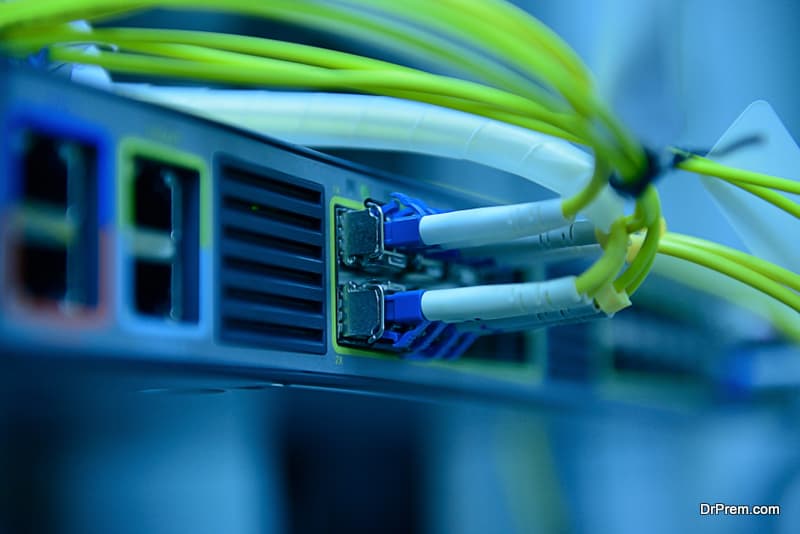Both fiber and cable internet serve as reliable networking solutions for residential and business users. They deliver more than enough speed for basic users and seasonal gamers, as well as competitive players and workaholics.
Apart from that, several providers offer these services. For example, for fiber connection, you can go for Optimum internet, as they provide both affordable and high-end multi-gig fiber packages. On the other hand, for cable connection, you have Spectrum internet, which offers decent speeds with wide availability. In addition, you have many othertop internet service providers, so at least one will be available in your area.
Still, even with all the similarities, both fiber and cable internet are far apart in terms of service. We are here to find out how!
What is Cable Internet?
Cable internet delivers internet to your home over copper coaxial cables, the same cables that are used for cable TV service. It does not require any costly infrastructure and is available in almost 90% of the US.
However, cable internet speeds are asymmetrical. It means your upload speed will be much lower than your download speed. Still, modern-age cable networks are more powerful and robust and can deliver gigabit-speed internet.
What is Fiber Internet?
Fiber optic internet, on the other hand, utilizes glass fibers for cables that transmit data as light pulses. It makes data travel at almost the speed of light. However, it needs a special network that may get costly and has limited availability based on the provider and plan.
The plus point with fiber internet is that it provides symmetrical speeds. It means your download and upload speeds will be equal. As a result, it is beneficial in more ways than one. For example, video conferencing needs a stable download and upload speed to work ideally. So this makes a fiber connection very reliable for businesses and multinational companies.
Fiber Optics vs Cable Internet
The biggest selling point of fiber internetover cable internet is the symmetrical connection. It makes both downloading and uploading easier and much faster. Moreover, a fiber connection can deliver up to 10 Gbps speeds, with more research underway. Recently, acombination of 22 cores cable with wavelength division multiplexing and SDMgave a contextual speed of 2.15 Pbps(1Petabit = 1,000,000 Gbps), destroying all world records.
However, this is only in research, and right now, we do not want to destroy the existence of cable internet; we just want a normal comparison. So here it is!
1. Structure
Cable internet uses the same coaxial cable technology that is used to deliver cable TV service. The coax cable surrounds the copper core insulated with aluminum, a copper shield, and a plastic cover. A big advantage of coax cable is that service providers can bundle up the internet with TV. However, to access the internet, you would need a modem.
On the other hand, fiber optics cables are used to deliver fiber internet. Here, the data is transmitted over thin plastic or glass cable channel that transmits it at light speeds. Moreover, these fiber strand cables can deliver data over longer distances and with great reliability. However, the package and installation may be somewhat costly for many people.
2. Availability
In terms of availability, cable internet is available in almost 90% of the US, and it is the same in other countries too. In short, if you can access cable TV, you can also have a cable internet connection.
On the flip side, despite being more reliable, fiber internet is not easily available. Still, they are slowly covering more areas and will soon get upgrades in terms of power as well as coverage. However, this shortage is mostly in remote and underdeveloped areas. In metropolitan cities, you will have no difficulty finding at least one good fiber provider.
3. Reliability
Both fiber and cable connections are equally reliable, but the fiber is much better than cable. It is so because the factors that affect electricity can also impact cable connection. So, if you reside in an area where frequent power outages are a thing, cable internet might not be best for you.
In contrast, you can access the web via fiber internet even without electricity. It is so because the cable contains glass fibers that don’t conduct electricity. This also protects the cable from voltage shifts and fire breakouts. So, it makes fiber internet much more reliable than a cable connection.
4. Speed
Cable internet can deliver up to 1,200 Mbps speeds.One of the fastest cable internet is provided by Xfinity, with 1,200 Mbps download speed, but only 35 Mbps upload speed.
In comparison, fiber ensuresa symmetrical connection that delivers equal download and upload speeds. The biggest breakthrough here comes from Xfinity. Their hard-to-find 6,000 Mbps or 6 Gbps internet delivers the same speeds both ways, making it one of the fastest on this planet.
5. Cost
Coming over to costsdiffer a lot. The first thing that affects the pricing is the deployment and installation cost. It is obviously more in the case of fiber connection. Here are some of the providers that offer these services:
| Provider | Connection Type | Price starts from |
| CenturyLink | Fiber | $70/mo. in select markets. |
| AT&T | Fiber | $55/mo. plus taxes. |
| Spectrum | Cable | $49.99/mo. for 12 mo. |
| Optimum | Cable | $40/mo. for 12 mo. plus taxes. |
These are only some of the top best providers, out of which Optimum internet providers offer affordable and some of the best deals. For more providers, discounts, and bundled options, go to: https://www.buytvinternetphone.com/
Final Takeaway
For most people, cable internet is the better deal because of bundle options and entertainment services. In addition, the high-tier options for several providers are more than enough for daily tasks as well as heavy activities.
On the other hand, fiber internet offers more speed, multiple-connections and proves to be better in many ways. These include people who attend online classes, video presentations, etc.
So, at the end of the day, it all comes down to personal choice. Consider the points we mentioned above and see what best fits your needs to go online.
Article Submitted By Community Writer




